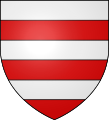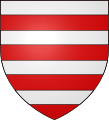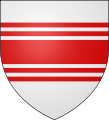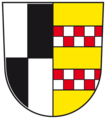Beam (heraldry)
In heraldry , a bar is a herald's image created by two dividing lines in the field.
The Ritterstrasse is horizontal, the sloping beam is inclined, always from heraldic right (front) top to bottom left - bottom right to top left is called oblique left bar and is largely an independent image.
The beam should not be confused with the post , which is vertical. In Anglo-French heraldry, the belt-like bar ( English fess , French fasce , cf. 'Fessel, Fasche') and the sash-like sloping bar ( bend , bande ) are conceptually more strictly separated.
Blason and Tinging
Bar (Ritterstrasse)
The horizontal bar is also used comparatively as ribbon, ribbon, bandage (in the binding shield ), belt; Street; Strut; Called a stroke , especially narrower forms (English bar / bendlet ).
As with the coat of arms , the design can accommodate all colors, shapes and figures, but the middle space must always have a different color ( tincture ) than the top and bottom. The upper and lower division, if not cut the same, should also be mentioned here.
He can rimmed (with board provided) gestückt, flamed and even after all arms cuts be of the whole shield separated. The aim is the same-sided cut figure. Herald pictures and common figures are possible in the bar.
If it is not in the middle, that is, if it is shifted slightly upwards, it is emblazoned (described) as elevated or otherwise as lowered . The bar can also be shown several times in the coat of arms, but then a narrower shape is chosen.
Sloping beam
A diagonal bar , also diagonal bar , cross bar , cross brace , coat of arms sash , is created when a shield is divided into three places by two parallel, inclined lines , two of which must have the same tinctures . The sloping beam must run diagonally to the right, i.e. from heraldic front / right- top to back / left-bottom (\).
Inclined left bar
The oblique left bar is created like the oblique bar, but it runs obliquely to the left (from heraldic left (back) -up to front (heraldic right) -below). In older coat of arms descriptions, the term Schreffe can be found for this sloping beam .
Multiple bars and division
Several bars are described either as such or divided ( obliquely divided, obliquely left-divided , English barry / bendy / bendy sinister , French fascé / bandé / taillé ), depending on whether there is an even or an odd number of fields. It should be noted that counting is different in German than in Anglo-French heraldry: Every two fields of each color are called German three-fold (three dividing lines), English but barry / bendy of four (the upper color is then mentioned first, for all diagonal lines Divisions so those of the heraldic upper left corner), while two of the one and three of the other color German two bars , English. two fesses / bends are emblazoned on the other base color (therefore there is no “barry / bendy of 5” and no “6-fold divided”). Divided, one also emblazoned when there are different colors above and below, for example: Red, a silver bar (red-white-red), but divided by red, silver and blue (red-white-blue, "triple") then unnecessary, English tierced per fess 'cut into thirds from the beam'). If the number of divisions remains undetermined (because there are many, or the number is irrelevant), one speaks bar- wise red-gold (red begins; English barry - without addition).
The character of the first and third shield is one-colored with a herald's image, the second and fourth are two-colored, without any further decoration.
Twin bar and thread / bar / stake
If the width of the bar is less than half (about 2/7 to 1/3 shield width), it is referred to as a thread , bar or stick ( English barrulet ).
If two bars run parallel and the sum of the two bar widths including the distance between them have a normal bar width, they are emblazoned with twin bars.
In French heraldry, the width was reduced to the width of a thread, and is referred to as twin stripes ( bars gemelles ) or double stripes ( barrulet ) . With three threads it is triplet strips .
If the beam is accompanied on both sides by a thin beam, it is said to be accompanied by two strips, if they are adjacent, if it is bordered, if one is on top , the beam is said to be covered with a strip. This is also possible with other numbers of strips. The accompanying strips are usually the same color, otherwise this is noted, the others are inevitably tinged differently.
Other forms
A shifted or offset bar can be read in coat of arms descriptions if the front (right) and rear (left) part of the bar is separated by a straight or angled cut and offset (shifted) by its width up or down. This Herald's picture is called the edge bar and is divided into right or left edge bar according to the higher part. If only moved halfway around the beam width, it's a half edges bar , which is also described by the raised side. A break beam is missing one or more pieces in the middle.
In connection with a right or left post of the same bar width and the same bar color moved to the edge of the shield , it becomes a right or left flank bar or side bar . There cannot be a hyphen between the two.
Another shape is the paw beam . In this case, the two ends widen.
If the bar is so completely pointed on both sides that it disintegrates, it is called a diamond bar or wecken bar (English fusilly , French fuselée ; however, if the diamonds or wecken are not cut into), one emblazoned diamonds abutting or touching each other , French fusée ).
Tinging, section and allocation of the bars
Like all Herald pictures, the bar can be freely tinged, from monochrome to split by ... and divided by ... (note that the bar is divided into two colors along its direction , the diagonal bar is then split , and vice versa), the two mixed as square , also diagonally square across the diagonals, split / divided several times (about five times divided by red and gold , i.e. five dividing lines: three red, three gold fields), up to shaft .
Can bar with all sorts occupied , and any of the edge cut to be.
The bar is not emblazoned as floating (free-standing, not touching the edge of the shield), this rectangle is called a shingle
A red ornamental band of three five-pass rosettes ( Krakauhintermühlen , AT)
Special beams
Tie of Austria: silver on red
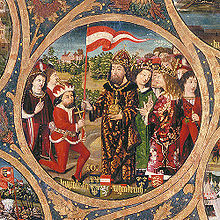
Only in the case of the Austrian binding shield one speaks of binding for the beam. The name Binde goes back to the - historically unsustainable - Acre legend , according to which the Babenberg Duke Leopold's robe was not red with blood only on the belly band after the battle in front of the castle.
Nested beams
Cistercian bar: two rows of silver and red sheathed
In communities in the districts of Sigmaringen and Ravensburg and in other communities, the inclined bar in the coat of arms can be found as a fixed area-related term Cistercian bar in many coat of arms descriptions. Derived from the coat of arms of the Cistercian order, the name after Saint Bernard of Clairvaux is also called the Bernhard coat of arms or Cistercian donut ribbon . It is supposed to show the relationship with the Cistercian monastery . Applying this designation to all such bars is not permitted.
Märkischer Schachbalken: Three rows of red and silver pods

The Brandenburg chess bar , popularly also known as the chess board bar , was the coat of arms of the Counts of the Mark in Westphalia on a golden background . To this day, the nested bar can be found in numerous coats of arms of the eastern Ruhr area or the Hellweg area and the western Sauerland. The chess bar was originally accompanied by a growing lion, but this disappeared from the middle of the 13th century. The nested bar first appeared in the coat of arms of the Counts of Altena and Mark at the beginning of the 13th century. Due to the pronounced marriage policy of the counts and later dukes, the chess bar can be found in many coats of arms of related families and regions in Germany. The last Counts of the Mark - by inheritance 1609/66 - were the Prussian kings and German emperors, who continued the slaughtered beam in the great Prussian coat of arms . The coat of arms can also be found in numerous secondary lines - marital and illegitimate - and families by marriage in France, Belgium, the Netherlands, Italy. In modern coats of arms there is occasionally a modification of the march-shaped bar, in which the silver and gold are replaced.
Battlements
A beam with attached squares at the same length (battlements) is emblazoned as a battlement beam . If they are also in the same position on the underside , if it is a counter battlement beam , if they are offset, an alternating battlement beam as in the old coat of arms of the Counts of Berg . Instead of the square battlements, flat (half height, double length), cross (flat battlements with cross), broad (dovetail-shaped), graft (attached disc), yoke (cut-out disc), pointed (attached triangle), Welsch (cut out triangle), Rochzinnen (attached, outwardly curved horns) stand. The Welschzinne is also called Kerbzinne, Schwalbenschwanzzinne, Scaliger- or Ghibellinenzinne.
Ammerland beam
This form of representation goes back to a bloody legend .
Beam with meander border
In French heraldry , bars are often lined with a meander ribbon on both sides or brought directly into the coat of arms. In the coat of arms it is always a rigid linear form and is not sinuous like the meander in rivers. There is a thin, thread-thin gap in shield color between the bar and the meander. The color of the meander line is often determined by the bar, the actual meander line by the translucent shield color. The meander line itself can also differ from the bar color and z. B. appear in gold or silver. The shield color shines through the free areas. These edge design is to report to the blazon, as in the coat of arms of Buxeuil (Aube). ", Both sides lined in red a silver oblique beams of just such a meandering" or the emblem of the department of Haute-Marne with differing tingiertem Mäandersaum: "In blue one silver post with a golden meander border on both sides. ”In addition to the beams, these decorations can also be found on inclined beams, posts , brackets , shield base and shield head . The meander border has no meaning, as an ornament it is just a heraldic whim.
See also
literature
- Gert Oswald : Lexicon of Heraldry. VEB Bibliographisches Institut, Leipzig 1984. (Also: Bibliographisches Institut, Mannheim / Vienna / Zurich 1985, ISBN 3-411-02149-7 )
Web links
Individual evidence
- ^ Oswald: Heraldry. 1984, p. 356.
- ^ Oswald: Heraldry. 1984, p. 61.
- ↑ Orders and Congregations Orders online





